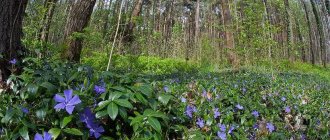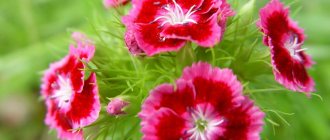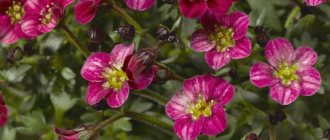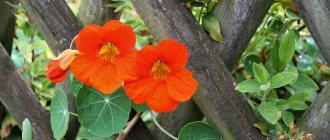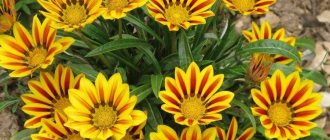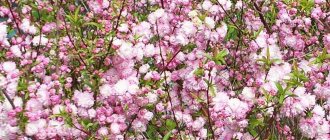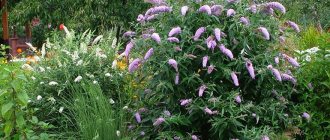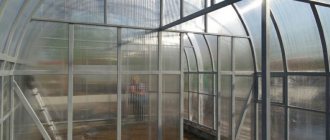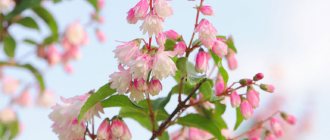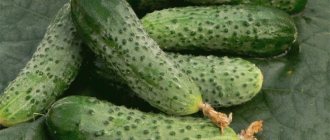Author: Elena N. https://floristics.info/ru/index.php?option=com_contact&view=contact&id=19 Category: Garden plants Published: February 27, 2019Last edits: January 20, 2021
- When to plant
- Growing conditions
- How and when to collect seeds
- Bluebell annual
flowers (lat. Campanula) belong to the genus of herbaceous plants of the Campanula family, which includes more than three hundred species growing in places with a temperate climate - in the Caucasus, Western and Central Asia, Europe, Siberia, and also in North America. Bells prefer steppes, meadows, forests, desert areas and rocks. Many species of these flowers grow in alpine and subalpine mountain belts. The Latin name is translated as bell. People call these flowers chenilles, chebotkas and bells.
Description and features
Garden bellflower is a herbaceous plant from the Campanaceae family.
Grows in temperate latitudes with a continental climate. There are more than 400 species of this crop. Presented as an annual, biennial or perennial. Often used to decorate flower beds. The stem can be erect, creeping or branched. The plant can be short, medium-sized or tall (up to 1.55 meters in length). The root system is taproot or rhizomatous. The leaves are arranged in regular order.
They are oblong, lanceolate or semicircular in shape, with a serrated, zigzag or smooth edge. The size of the leaf blades and the length of the petioles gradually decrease towards the tip of the shoot. At the base of the stem there are basal leaves. The flower is very similar to a glass or bell. Inflorescences are racemose or paniculate. The flower is bisexual, regular, on a peduncle. May have blue, white, blue color.
It blooms all summer and is pollinated by bees. After pollination, a fruit is formed - a capsule with tiny seeds inside. Propagated by seed or vegetatively.
The coloring pigment that gives the bluebell its delicate blue color is susceptible to acids. If you plant a flower in acidic soil, it will instantly turn red. This feature of the plant can be used to determine the acidity of the soil. You can sprinkle a freshly cut bell with soil and watch the reaction. If it changes color to scarlet, it means the soil is very acidic.
Application in design
When arranging a garden, biennials are used both independently and in combination with other plants. The photo of the middle bell Mix of colors shows that it and other varieties are used:
- as part of flower beds, mixborders and alpine slides;
The medium bell goes well with low perennials in flower beds
- for design of walking paths;
A medium bell planted along the path draws attention to it. - for the formation of artistic borders;
When planted tightly, the blooming middle bell looks very attractive
- for growing in flowerpots.
The average bell can be grown in a pot on the terrace
You can combine biennials with marigolds and phlox, roses and carnations, clematis and astilbes. The culture feels comfortable next to any perennials that prefer light and moderate moisture.
Important! It is better not to plant the average bell with loosestrife, forget-me-nots, marsh callas and sedges. They all love high humidity, which can be dangerous for a two-year-old plant.
Biennials are not recommended to be planted in close proximity to trees and tall shrubs. The flower will not be able to show maximum decorativeness and, moreover, will be forced to compete for water and nutrients.
The only one for the windowsill
The best species for growing indoors is the Campanula equifolia, or in European style the Italian Campanula, where it grows naturally.
Bellflower (Campanula isophylla) is a perennial plant that can survive and bloom for many years if certain maintenance conditions are met. Many varieties have been developed, differing in size, color and structure of flowers.
More information about the bellflower and its varieties can be found on the Bellflower page.
|
What you need to plant bluebells
This plant is light-loving. The room should be well lit, while avoiding direct sunlight. The temperature should be no lower than 15 degrees. Be sure to water regularly. Loosen the earth. Spray the leaves periodically. Care should be careful and polite so as not to damage the thin stems.
Transplantation is carried out in the spring. The contents of the pot are carefully lowered into the hole. Sprinkle soil on top and moisten. After flowering, you need to remove dry inflorescences. It is imperative to remove all weeds.
Important! In the future, make sure that no weeds appear around the bush, as they will interfere with the normal rooting process.
Features of cultivation
When growing a plant, you need to consider several features:
- It is necessary to promptly remove dried flowers. This stimulates the formation of new buds, so flowering will be abundant;
- in October, the stems need to be cut, and then the root system should be insulated with fallen leaves and peat;
- tall varieties should be tied up so that they do not bend or break from gusts of wind;
- the bush is renewed annually by planting new cuttings;
- if the leaf blades begin to turn yellow from too bright rays, the bush must be shaded.
Preparing for landing
Before planting, seeds should be treated with a 1% solution of potassium permanganate for disinfection; they have good germination, so there is no need to use growth stimulants. After processing, they need to be dried with a dry cloth or napkin.
For planting, you can use a ready-made substrate for flowering crops or prepare the soil yourself. The optimal composition is fertile soil, humus and river sand in a ratio of 2:1:1. For planting, only a common container is required; bells are not picked.
When to plant
Bells are planted in open ground when there is no threat of spring frosts. In warm regions, you can plant seeds or cuttings from the end of April or early May; in cold regions it is recommended to wait until the end of May or even the beginning of June.
In the south, perennial bluebells can be planted for the winter. The procedure is carried out until the first half of October, then the planting must be covered with peat and fallen leaves with a layer of up to 20 cm. To obtain seedlings, bells are planted at home in the first half of March.
Selecting soil and planting location
The area should be well lit and protected from gusts of wind. The soil solution is neutral or slightly alkaline. The soil must be drained; before planting, it must be dug up and weeds removed.
Planting scheme
The seeds are poured onto well-moistened soil at a distance of 1 centimeter from each other, sprinkled with sand. Then it is irrigated with water and covered with transparent glass on top.
Planting process
The seed method of planting bells has some features. Step-by-step algorithm:
- Fill the container with substrate, lay a drainage layer 3-5 cm thick on the bottom. It is convenient to use expanded clay or pebbles as a material. After this, the soil should be watered generously with warm water.
- The seeds are sown to a depth of 2 cm, then sprinkled with a layer of fertile soil and watered again.
- The container with seedlings should be kept in a well-lit place at a temperature of 17-20°C. To speed up the emergence of seedlings, it is advisable to use a glass or film cover. No additional lighting is required.
- The first shoots appear 10-14 days after planting; in apartment conditions they need to be kept for another 20-25 days for the first leaves to form and the root system to become stronger. During this time, you need to monitor moderate soil moisture, loosen the soil and remove diseased leaves.
- The planting area is dug up to a depth of 20 cm, planting holes are dug with an interval of at least 15 cm between plants.
- Replanting to a permanent location should be carried out in dry and warm weather. After transplanting the seedlings, the plants need to be watered generously with warm water and nitrogen fertilizing, which is suitable as organic matter - peat or mullein solution.
After planting, the flowerbed needs to be mulched; there is no need to provide shelter from the cold, since the bells have quite strong frost resistance. It should be borne in mind that with this method, flowering may not occur in the first year.
Indoor types of colors
Many different color varieties of koleria have been bred. Flowers often combine several shades and are decorated with dots and strokes. The varieties also differ in the size of the plant and bud.
The Colombian bellflower comes in standard, compact and miniature forms.
Standard varieties:
- Coleria foxglove has shoots up to 80 cm long. The leaves are light green, 15 cm long. A bell with a pink tube and a light green speckled limb.
- Koleria fusiflora is a very elegant variety with dark green leaves with red edges and reddish fibers and large orange-red flowers with yellow dots. Blooms for a long time.
- Koleria Jester is a fairly large variety. Velvety emerald foliage with a bronze touch. The petals of the burgundy tubes are decorated with dark dots.
- Koleria bogota up to 60 cm tall with green leaves. The bud is yellow-red, with purple specks inside the petal.
- Coleria pleasanta has shorter shoots - up to 40 cm, dark green fuzzy foliage and pink flowers with a crimson pattern.
Compact varieties:
- Koleriya Varshevich - 40 cm tall. The flowers have an original color - the tube is lilac with silver fibers, the lemon-colored petals and pharynx are decorated with crimson dots.
- Koleria Eriantha is a bush with green leaves decorated with a red border. Petals of scarlet fuzzy tubes with burgundy dots. The tube inside is yellow with specks.
- Koleria Linden is 30 cm high. It stands out for its spectacular foliage: dark green, pubescent. The flowers are purple with spots.
- Koleria Red is the most common species with red flowers. The petals are ruby with specks, red rays emerge from the pinkish-white throat.
Miniature colors:
- Coleria poppies with small yellow-orange bells in red spots, turning into a border. The leaves are rich green with spots.
- Koleria Ganymede is an unpretentious plant. Orange flowers with red dots on yellow edges contrast with smoky green foliage.
- Koleria Flet blooms for a long time with crimson bells with spots on light petals. Pearl-green foliage is also decorative.
Indoor varieties of koleria - photo gallery
Koleria Varshevich is valued for the original color of its flowers. Koleria fusicolor is characterized by velvety dark green leaves with pubescence.
Koleria Bogota has an amazing bud color - yellow-red with burgundy specks
Kohleria Linden is distinguished by decorative leaves with stripes and spots
Petals with large dots look impressive against the background of the red-burgundy tubes of the Jester variety. Koleria Ganymede is a miniature, unpretentious variety. The miniature Flet variety is distinguished by long-term flowering.
Coleria Erianta has green leaves with a red border.
Kohleria red is the most common species
Koleria Maki - a miniature variety with bright orange spotted flowers Koleria foxglove - a large, densely pubescent plant Koleria pleasant has bright pink flowers with a speckled pattern
Types of colors - video
How to grow bluebells from seeds
Most species repeat the properties of the parent plants, and they can be propagated by seeds. Some varieties, such as terry varieties, may differ from their parents. In this case, they are propagated vegetatively.
Bluebells produce very small seeds and should be placed on the ground under a thin layer of sand. In the 2nd half of October or May, the seeds are sown in the ground. You can grow seedlings starting in March. To do this, prepare light soil from a mixture of peat, turf soil and sand, without the addition of organic fertilizers.
Germination of seedlings occurs 2 weeks after sowing. When 3 true leaves appear, the seedlings dive after 10 cm. Plants are planted in a permanent place in early June. Flowers and seeds will appear within a year.
Reproduction methods
In garden conditions, bells can be propagated in three main ways:
- Seeds. This method is rarely used, since with the seed propagation method, varietal qualities are lost, and the plant practically does not bloom in the first season. Not suitable for terry varieties;
- Cuttings. Planting material is prepared in March or early April. Cuttings are prepared from healthy and strong young stems, which are then planted in a container with fertile soil for subsequent rooting. After the appearance of strong roots, you can transplant into open ground;
- Dividing the bush. Suitable for adult bells, the method is often combined with a planned transplant. In the fall, the bush is dug up, and then divided into 2-3 parts and planted in a permanent place.
Despite the difficulty of seed propagation, this is often the only way to get new types of bells on your site. Planting material in the store is often represented by seeds.
Propagation of perennial bells by cuttings
We have already discussed above how to grow bells from seeds. Now let’s move smoothly to an analysis of such a topic as propagation by cuttings. For those bells that live for one year, propagation by seeds is suitable. For others that live for more than two years, cuttings and root division can also be used. If seeds are used at this stage, over time it will be impossible to distinguish between the varieties. In addition, terry seeds can be propagated exclusively by the vegetative method.
- In early - mid-spring, it is necessary to select cuttings from new stems or shoots at the root.
- Next, they are planted in a container with a light substrate and covered with a plastic bottle. Those leaves that are below must be removed, and those that remain are cut off to the third part.
- After 2-3 weeks you will already be able to see small roots.
- When sprouts appear, they can be transferred to a permanent area.
Growing bells from cuttings
Reproduction by dividing the bush
This method can only be used when the plant is at least 2-3 years old. This work is carried out in late spring, early summer. A large bush is removed from the ground. Those stems that are above the ground are trimmed with a disinfected knife with a sharp blade. It is necessary to divide the bush in such a way that each part has full roots, as well as renewal buds.
To treat the areas left after the cut, you need to use crushed coal or ash. Immediately after this operation, all parts are planted in the soil, which was previously generously watered.
7. Interesting facts, the meaning of the flower
The stems of bluebells become woody with age and the plant often becomes unattractive; it is advisable to replace it with a new one. The name “bell” was given to this plant for the shape of its buds, which indeed often resemble bells.
In Rus' there were several legends associated with this plant - for example, on the night of Ivan Kupala, people believed that they could hear the ringing of flowers.
Some varieties are considered edible and can be consumed, but other species are considered poisonous and can cause poisoning if ingested.
Bells are considered a symbol of purity and fidelity; bouquets of them were often given to young girls.
↑ Up,
Caring for bluebells
As in the natural environment, bluebells in the garden are completely unpretentious. It is enough to select a variety taking into account the characteristics of the regional climate, soil and landscape of your site.
Temperature and lighting
The vast majority of bellflower species need a warm, open and bright space. You should not plant them in the shade of trees or other bushes, because they will not grow well.
Watering
Bluebells practically do not need watering. Regular watering of the planting is necessary only in dry and arid weather; at all other times, you should monitor the condition of the soil, preventing it from becoming waterlogged or drying out. As a rule, watering is carried out 1-2 times a week; if there is precipitation, it is not necessary to water the bells. The moisture should be soft and settled; it is advisable to use rain or melt water.
Top dressing
For the first time, fertilizers are applied in the spring before the start of the active stage of the growing season, for which nitrogen compounds are used, for example, urea (urea) at the rate of 15-20 g/1m2. Closer to flowering, it is recommended to add any liquid complex composition for ornamental flowering plants, but you can also use nitrophoska 20-25 g/m2. On poor soils, superphosphate is added to the soil in the fall in a volume of 40-50 g/m2.
Garter to support
Tall bells need to be tied to a support. Pegs or mesh are used as support.
Loosening, mulching
To maintain soil aeration, loosening to a depth of 3 cm is carried out as a dry crust appears on the upper surface of the soil. It is advisable to carry out the procedure after each watering to avoid water stagnation. During the season, it is necessary to remove weeds in a timely manner; it is advisable to maintain a layer of mulch. It is supplemented as necessary; the mulching thickness should not exceed 5 cm to avoid overheating of the roots.
Stepsoning
The stems of the plant need to be pinched, removing excess lateral or apical shoots. It is advisable to remove dried leaves and flowers from the bush.
Topping
The top of the stem should be pinched at the very beginning of summer. This procedure stimulates the growth of side shoots, and the stem will not stretch too much.
Trimming
Bells will bloom for a long time if you constantly remove fading flower stalks. In autumn, the stems of the plant should be completely cut off.
Transfer
Not all types of bells tolerate transplantation well, so it is advisable to carry out the procedure as rarely as possible. The plant can grow comfortably in one place for 4-5 years, then the intensity of flowering decreases, the shoots form weak and thin. Transplantation is carried out in the fall after flowering and the formation of seed pods. First, the bush must be cut to a height of up to 20 cm, and then dug up and, together with a lump of earth, moved to a new place. After this, the plant should be fertilized with organic fertilizer and the bush should be prepared for winter.
Adenophora
Adenophora is a close relative of the bell, which is easy to guess from its popular name - bell.
Using hedgehogs to process potatoes
Types of seedling cassettes and their use
Hazelnut - how it grows and blooms, growing a nut in the garden
This herbaceous perennial is unpretentious, can grow in both sun and partial shade, is undemanding to the type of soil, and does not require shelter for the winter. Keep in mind that adenophora needs good soil drainage and does not grow well in acidic soils.
Bellflower blooms most of the summer. Easily propagated by seeds. In this case, winter sowing is preferable. If you did not have time to sow bells in late autumn and plan to sow in the spring, it is advisable to stratify them for a month (keep them in the refrigerator).
Collecting your own seeds
Seeds are collected in early autumn, choosing the healthiest and most lush specimens. Unfortunately, varietal varieties (hybrids) do not inherit 100% of their characteristics, so some of the seedlings grown from seeds from their own collection “go wild” - they will have a classic blue color.
Preparing for winter
One- and two-year-olds do not need preparation for wintering. But perennial plants need to be properly prepared for exposure to low temperatures. In the third ten days of September, all shoots must be cut to the lowest point. Frost-resistant varieties will easily survive even a cold winter. And southern, heat-loving varieties need to be protected. To do this, after pruning, they are sprinkled with dry leaves or spruce branches on top.
Tall plants are sprinkled on top with a dry mixture of peat and humus. The thickness of the layer must be at least 30 centimeters.
Thus, bells are unpretentious flowers to care for. They are used to create bright compositions in landscape design. Despite their ease of care, bells are an excellent decoration for a front garden, flower bed or vegetable garden.
Pests and diseases of perennial bells
Bells, unlike many garden plants, are very unpretentious in planting and care, which is why special effort is not required in growing them. The cause of damage to bells by various diseases can be improper watering, as well as growing plants in one place for a long period. Because of this, harmful bacteria can accumulate in the soil, which can cause disease.
- Most often, bells are affected by bacteria such as Fusarium, Sclerotinia or Botrytis. To combat pathogens, it is enough to treat the flower bed twice a season (in autumn and spring) with a 0.2% solution of Fundazol. It is advisable to replant plants to a new location from time to time.
- High humidity can cause a slobbering captive to appear on the flowers of the bell. This insect can easily destroy all the flowers in a fairly short time. To combat it, use a tincture of garlic in water, which is sprayed on the bell bushes.
- Low-growing plant varieties are threatened by slugs. They often have to be collected by hand. Among the preparations for combating these pests, superphosphate, which is poured around the stem, is very helpful, and among folk methods - tincture of hot pepper, which is used to search the plants.
Datura
Datura common (photo below) is difficult to confuse with other plants. He is big, even huge. The bush can grow up to a meter in height. The leaves are beautifully cut. They look powerful, fresh, attractive (for those who eat grass). Only animals will not feast on them. They are repelled by a strange, even disgusting smell. Datura plant can be found in large quantities in any area. Typically, Datura chooses the following areas for its habitat: wastelands, roadsides and vegetable gardens. Datura grass flowers are so magnificent that this plant has attracted the attention of landscape designers. It can be seen in flower beds and lawns. The plant is used as an ornamental. Moreover, it has a fairly long flowering period: almost all summer (depending on climatic conditions) it delights viewers with huge bowls of white flowers. You just need to keep in mind that the plant is poisonous. Flowers can be intoxicating (hence the name) with just their scent. In hot weather, in the absence of wind, it concentrates around the plant. It is not advisable to plant such “decor” in the area near children’s playgrounds, institutions, cafes, and so on. Kids may not realize that they should run away from a cloying aroma. The result is a hospital.
Possible problems
If you do not follow the basic rules for caring for garden campanula, some problems may arise:
- for planting you need to choose a well-lit area, otherwise the growth of the plant slows down and the stems stretch;
- the soil must be drained so that moisture does not stagnate and the roots do not rot;
- it is necessary to water the bushes in a timely manner so that the soil does not dry out and the plant does not suffer from water deficiency;
- the soil needs to be loosened, the root system needs oxygen.
Aquilegia
A beautiful and unpretentious plant, distinguished by a variety of shades. Its delicate flowers last all summer and stand well when cut.
Aquilegia is not afraid of frost and tolerates heat well. It is only important to water and fertilize it on time.
In return, she will delight you with lush greenery and abundant flowering. Thanks to the variety of varieties, various options for planting crops on the site are possible.
